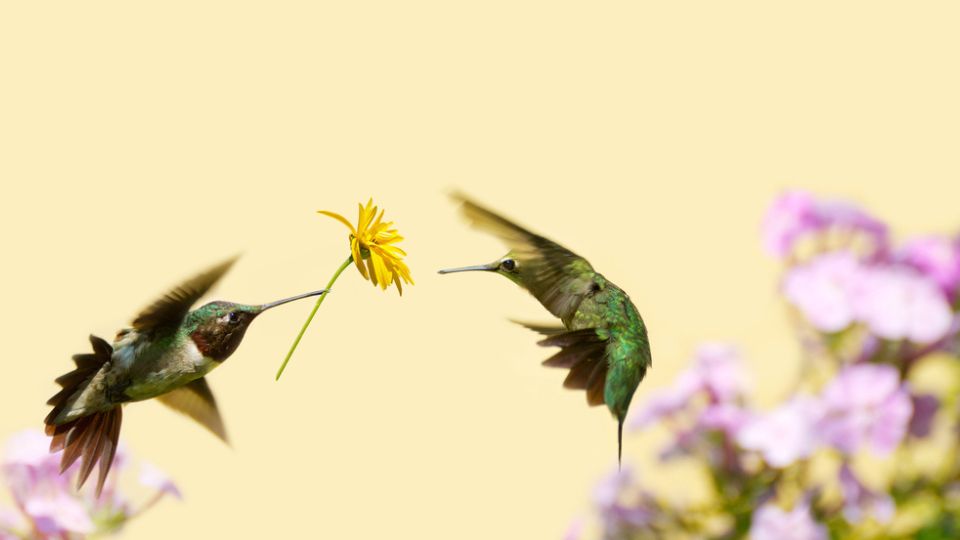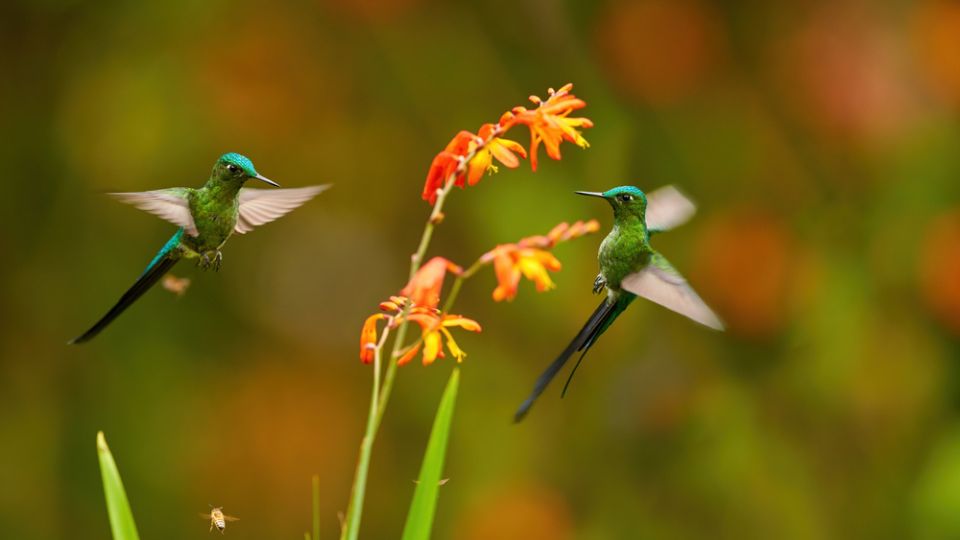There are many hummingbird myths, such as being lucky or having spiritual significance. These and other ideas are based on superstition and not based on fact. The reality of these magnificent, intelligent birds, is even more amazing.
Hummingbirds are lovely and mysterious birds. As a result, there are many hummingbird myths that exist—many are simply not true. For example, they don’t migrate on the backs of larger birds and don’t eat only red-colored nectar.
Additionally, they have a poor sense of smell, so touching the babies to rescue them is somewhat safe. Check out other common hummingbird myths and expand your knowledge about these birds.
Table of Contents
Are Hummingbirds Good Luck?
Hummingbirds are considered a sign of hope and good luck. Their unique features make them essential as totems in various cultures. For example, Aztecs connected these birds with the god Huitzilopochtli, thinking it was made from hummingbird feathers.
Ancient Mayan believed hummingbirds were “a sun in disguise.” Additionally, Native American cultures saw these birds as healers and bringers of joy and love.
The Cherokee created many myths and legends around hummingbirds. Myth 1 is the race between the crane and the hummingbird. Myth 2 is that hummingbirds brings back tobacco.
What Does It mean When Hummingbirds Comes Close to You?
If a hummingbird crosses your path, it’s usually considered a positive omen. First of all, their approach means they see you as a trusting and peaceful person. Many believe they are sending messages about the close people who passed.
Hummingbirds are also very intelligent, and they might want to let you know that their feeder is empty. Some in Central and South America still believe in the mythical powers of the hummingbird.

What Does a Hummingbird Mean Spiritually?
Being visited by this bird means you should appreciate life and little pleasures. It’s said, the spirit of the hummingbird is there to remind you to open up to your loved ones and allow them to see your soul.
Their meaning also reminds people to let love and light enter their lives. Generally, these tiny birds are considered a sign of good luck.
Do Hummingbirds Migrate on the Backs of Larger Birds?
Some common migration myths include the one where hummingbirds migrate on the backs of other birds, like Canadian geese. Regardless of the species of hummingbirds, know that they migrate without the help of other birds.
Many hummingbirds travel long-distance only with the help of the fat they generated during summer. Their increased body weight helps them go all the way to the Gulf of Mexico to spend the winter.
They Only Feed On Red Flowers, and Nectar Should Be Colored
Most commercial hummingbird feeders have some red sections, likely because it’s well known that hummingbirds like red color. However, these birds have many food sources.
For example, they’ll also eat small insects for proteins. They are highly attracted to bright colors like orange, pink, and yellow, among others. If you wear these hues, they might even approach you.
This myth is also why many people use red dye while making sugar water nectar. Unfortunately, this is not good practice. Red food dye could harm the birds.
It’s best to use the standard recipe of 1 part sugar and 4 parts water without additives. Store the sugar water in the fridge and restock the feeders often to prevent mold.
Do You Need to Remove the Feeders to Encourage Birds to Migrate?
Another hummingbird migration myth is related to feeding hummingbirds during fall. Some believe that keeping the feeders up during fall and winter will stop the hummingbirds from migrating.
However, migratory hummingbirds move based on the day length and available light—not food sources. Wintering hummingbirds will stay around and survive the winter in the state of torpor. Keeping the feeders out will actually benefit them.

Hummingbirds Mate for Life
Birdwatching includes observing the mating cycle of hummingbirds, yet many birdwatchers believe hummingbirds stay together. This is a common myth since these birds are often associated with romance.
In reality, females and males will separate right after mating. Females will manage the nest and lay eggs, while males will look for another partner. In some cases, females will also chase off males if they approach the nest.
Hummingbirds and Bees Get Along
These tiny birds face many dangers in their habitats and feeding grounds, one of which is bees. Some hummingbirds may live in harmony with them, but many will try to fight them.
Additionally, a feeder with insects can become contaminated, which can hurt the birds. Luckily, you can do this to keep the insects away:
- Choose feeders that discourage insects
- Move the feeder to trick them
- Give insects their feeder
- Utilize insect traps
Are Hummingbirds Smart? Some Say They Aren’t
According to hummingbird facts, these tiny birds are super smart. Their brain is quite large compared to their body weight. They also have an excellent memory.
So much so that they’ll remember every flower in your garden and know how long it will take to refill. They will also remember your face and buzz around you when they want more food.
They Can Walk Around Like Other Birds
Unfortunately, hummingbirds can’t walk or hop around like other birds. Their legs are short and weak. This is why you’ll see them either flying around or perching on the branch.
They’ll also mate while perching. Still, they’re the only birds that can hover and fly backward.

Bonus — Other Common Hummingbird Myths
- Some say the hummingbird tongue functions like a straw. Instead, the tongue tip is a liquid-trapping device that changes shape.
- You shouldn’t touch baby hummingbirds because you’ll leave a scent. This is false, as a hummingbird’s sense of smell is not that powerful. Still, if you see fledglings, try calling experts for help, and don’t touch them to avoid hurting them.
- Folks in Central America still believe they bring love. While this is a nice thought, it’s rooted in magical thinking.
- Hummingbirds make noises with their voice. This is not true. The sound you hear during courtship dives comes from tail feathers.
Not all hummingbirds migrate, and not all that do go to the same place. For example, Anna’s hummingbird stays along the west coast year-round.
Rufous hummingbirds survive late spring snowstorms. The Ruby-throated hummingbird is migratory yet the most common bird in the US.
Hummingbird Myths Overview
Some believe that hummingbirds are bringers of good luck. While it’s a nice idea, the luck comes from simply having a change to observe this incredible bird.
If you were worried about keeping your feeder up, know there are some kinds of wintering hummingbirds around. Your feeder might help them survive the winter so you can enjoy the hummingbird sightings year-round.

